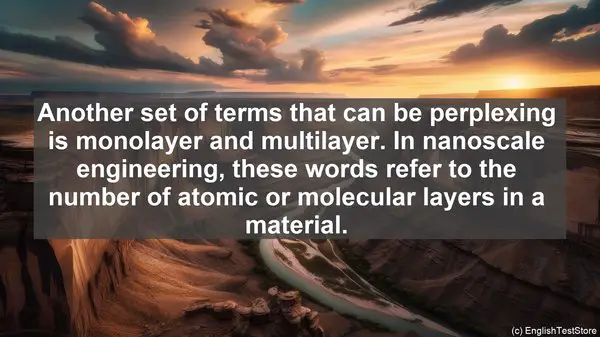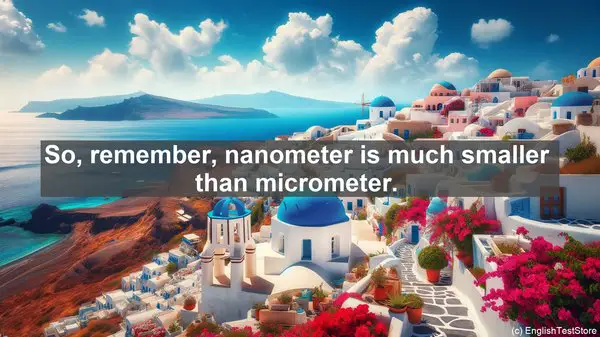Introduction
Welcome to today’s lesson on nanoscale engineering. In this lesson, we’ll be discussing the top 10 commonly confused words in this field. Understanding these terms is crucial for your success in this discipline, so let’s dive right in!
1. Nanometer vs. Micrometer
The first pair of words that often cause confusion is nanometer and micrometer. While both are units of length, they differ in scale. A nanometer is one billionth of a meter, while a micrometer is one millionth of a meter. To put it in perspective, the width of a human hair is around 100 micrometers, whereas the size of a DNA molecule is about 2 nanometers. So, remember, nanometer is much smaller than micrometer.
2. Monolayer vs. Multilayer
Another set of terms that can be perplexing is monolayer and multilayer. In nanoscale engineering, these words refer to the number of atomic or molecular layers in a material. A monolayer consists of a single layer, while a multilayer has multiple layers. For example, graphene, a popular nanomaterial, is often used in monolayer form, consisting of just one layer of carbon atoms. On the other hand, a multilayer material, such as a thin film, can have several layers stacked on top of each other.
3. Top-Down vs. Bottom-Up Fabrication
When it comes to nanoscale fabrication, two approaches are commonly used: top-down and bottom-up. Top-down fabrication involves starting with a larger piece of material and gradually removing parts to create the desired nanostructure. On the other hand, bottom-up fabrication involves building the nanostructure from individual atoms or molecules, gradually assembling them to form the final product. Each approach has its advantages and is suitable for different applications.
4. Nanoparticles vs. Nanocomposites
Nanoparticles and nanocomposites are often used interchangeably, but they have distinct meanings. Nanoparticles are individual particles with dimensions in the nanoscale range. They can be made of various materials, such as metals or polymers. On the other hand, nanocomposites are materials that consist of nanoparticles dispersed within a matrix. The presence of these nanoparticles can enhance the properties of the composite, such as its strength or conductivity.

5. Nanoscale vs. Microscale
While nanoscale and microscale both refer to small dimensions, they differ in magnitude. Nanoscale typically refers to the range of 1-100 nanometers, whereas microscale is larger, ranging from 1-100 micrometers. To give you an idea, a red blood cell is around 5 micrometers in diameter, while a virus particle can be as small as 20 nanometers. So, nanoscale is much smaller than microscale.
6. Quantum Dots vs. Quantum Wells
Quantum dots and quantum wells are structures that exhibit quantum confinement effects. Quantum dots are essentially tiny particles or clusters that confine electrons, leading to unique optical and electronic properties. On the other hand, quantum wells are thin layers that confine electrons in one dimension, allowing for control over their energy levels. Both structures have applications in areas such as optoelectronics and quantum computing.

7. Self-Assembly vs. Self-Organization
Self-assembly and self-organization are processes commonly observed in nanoscale systems. Self-assembly refers to the spontaneous arrangement of components into an ordered structure, driven by factors such as molecular interactions. On the other hand, self-organization refers to the emergence of patterns or structures in a system without external intervention. These processes are fascinating and have applications in fields like nanomedicine and nanoelectronics.
8. Surface Area to Volume Ratio
In nanoscale systems, the surface area to volume ratio becomes increasingly important. As the size of a material decreases, its surface area relative to its volume increases significantly. This high surface area can have profound effects on the material’s properties, such as its reactivity or ability to interact with other substances. It’s a crucial factor to consider when working with nanomaterials.
9. Band Gap
The band gap is a term commonly used in the study of semiconductors. It refers to the energy gap between the valence band, which contains electrons that are not involved in conduction, and the conduction band, which contains electrons that can move freely and contribute to electrical conductivity. The size of the band gap determines a material’s electrical properties, such as whether it behaves as an insulator, semiconductor, or conductor.
10. Nanolithography
Our final term is nanolithography, a key technique in nanofabrication. It involves the precise patterning of materials at the nanoscale, often using techniques such as electron beam lithography or nanoimprint lithography. Nanolithography is crucial for creating intricate structures and devices in nanoscale engineering, enabling advancements in areas like electronics, photonics, and sensors.
